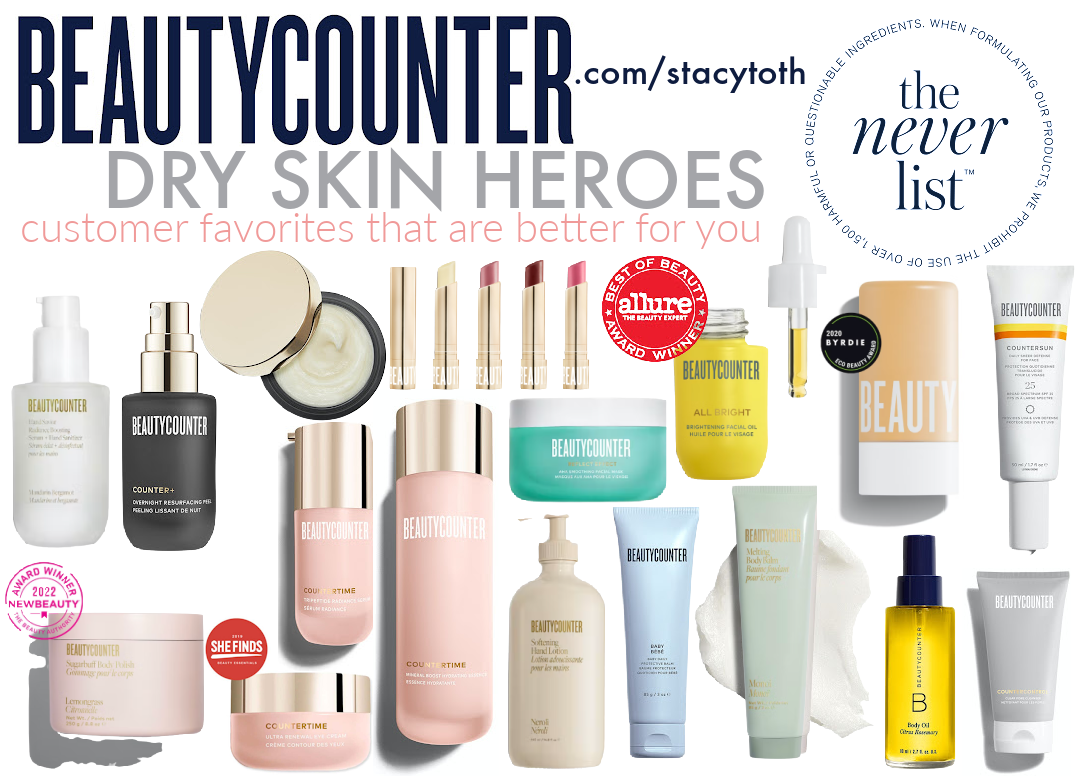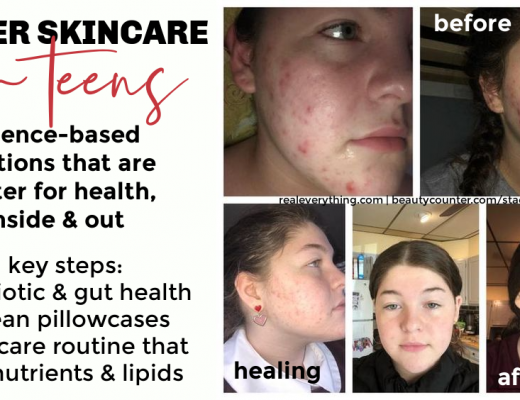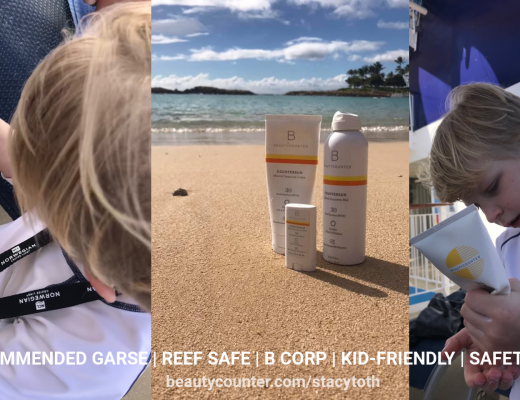[updated January 9, 2023] Winter is coming here in Virginia. Finally the air is cold, and skin is starting to feel dry, chapped, and cracked. Recently, I had several people tell me they were still using Vaseline on their dry skin. “Whatever you do, please don’t use that anymore! It’s only making your skin worse and more dry!” I proclaimed. I’ll go into more detail on that, but whether you switch to just coconut oil and lanolin or high-performance products that provide more tailored effects, ultimately the important thing is to just stop! Here’s 8 reasons petroleum jelly has NO place in your life and suggestions on what to use instead. ♥
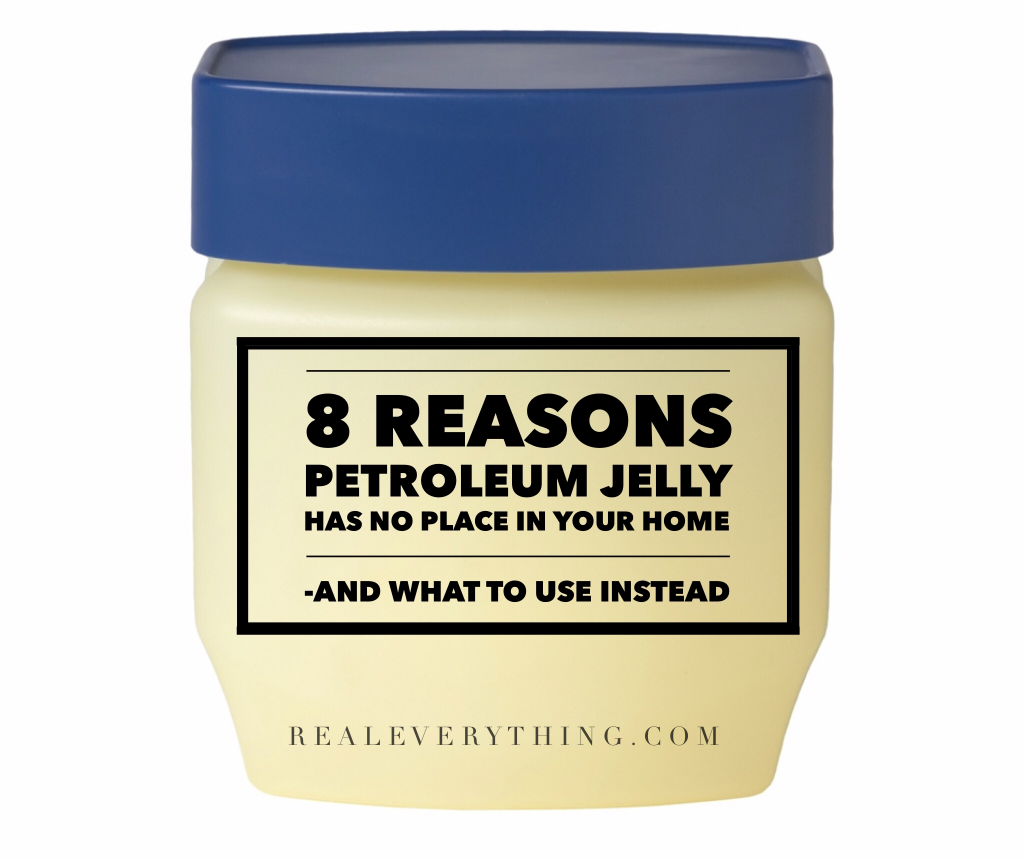
What is Vaseline and how is it derived?
Petrolatum, commonly known as petroleum jelly, is a byproduct of petroleum. It is a soft paraffin or wax mixture sold as a topical skin ointment. Petroleum jelly is a mixture of mineral oils and waxes, which form a semisolid, jelly-like substance. Originally discovered by oil workers who would use a gooey jelly to heal their wounds and burns, it was eventually packaged as Vaseline. (source)
Subsequently, we’ve learned this crude-oil byproduct has lots of risks and associated warnings – specifically, it is “for external use only” (always a red flag for me, since our skin absorbs everything). Even the Federal Food and Drug Administration (who I wrote about last month as having notoriously lax rules and regulation) restricts petrolatum in food to 10 parts per million, and insists that petrolatum used in food packaging or drugs meet governmental standards on impurity restrictions. (source)
Additionally, as detailed below, petrolatum or mineral oil jelly and mineral oils can cause skin damage. Petrolatum may interfere with the body’s moisturizing mechanism, leading to dry skin and chapping despite its cosmetic use as lip and skin protection. According to the Environmental Working Group, petrolatum may be found in one of every 14 products as well as 15 percent of lipsticks and 40 percent of baby lotions and oils.
EIGHT reasons to avoid petroleum-derived skincare products
1 – it’s a byproduct of crude oil waste (it’s not eco-friendly)
Petroleum jelly is produced from the petroleum process. The environmental impact of petroleum is often negative because it is toxic to almost all forms of life and its extraction fuels climate change. I don’t need to tell you that the process contributes to some serious ish, right? From toxicity, exhaust, acid rain, climate change, devastation from oil spills and waste oils, Wikipedia can tell you all about it if you wanna know more.
2 – contains carcinogens
According to the Environmental Working Group (EWG), a whopping 80 percent of all beauty products may be contaminated with one or more of the two dozen recognized cosmetic impurities that are linked to cancer and other health concerns. One of the scariest of these possible contaminants is called 1,4 dioxane, an impurity found in 22 percent of all petroleum-based cosmetics that is a possible human carcinogen and known animal carcinogen. How much you’re exposed to depends on the product you’re using: it’s in 82% of hair dyes, 45% of self-tanners and 36% of face moisturizers (source).
A study linking the petrolatum impurity polycyclic aromatic hydrocarbons (PAHs) to breast cancer was completed at Columbia University. The study indicates that breast tissue of women with breast cancer were 2.6 times more likely to have increased amounts of PAHs attached to their DNA than the breast tissue of women without breast cancer. PAHs are found in oil, coal and tar deposits as byproducts of fuel burning. Research found that PAHs were found in the mutated genes of test animals with mammary gland cancer. (source)
3 – what you put on your skin is absorbed to your blood stream
26 seconds is all it takes for 80% of what you put on your skin to be absorbed into your blood stream – which completely bypasses the liver. [Sources (1) and (2)] And petroleum-based products are no exception. The EWG reports say, These trace contaminants in petroleum-based ingredients often readily penetrate the skin according to government and industry studies, and their presence in products is not restricted by government safety standards — they are legal at any level.
4 – it will age your skin
Not surprising news flash: When you put a non-breathable, non-moisture-adding product that has carcinogens, it doesn’t nourish and hydrate your skin the way that is needed to prevent aging. The barrier process described in 8 below inhibits this moisturizing affect; there is also some concern about its potential to cause collagen breakdown. Specifically, when petroleum jelly coats the skin, it blocks the skin’s natural ability to breathe and absorb nutrients, which slows the cell renewal process and causes the skin to pull the necessary moisture and nutrients from within, leading to collagen breakdown over time. This is ultimately what causes wrinkles! (source)
5 – hormone disruption & estrogen dominance
Petrolatum is one of the numerous products which contain xenoestrogens, which are chemicals which cause hormone disruption and may throw estrogen out of balance in the body. Studies have shown that these chemicals may act on hormone receptors in the body and lead to estrogen dominance. A growing problem in today’s world, estrogen dominance is when the body has high levels of estrogen and proportionately low levels of progesterone to balance it. It is linked to infertility, menstrual problems, accelerated aging, allergies and autoimmune problems as well as nutrient deficiencies, sleep problems and even some types of cancers. (source)
6 – inhalation, consumption, or internal use can cause bacterial & fungal infections
A study published in Pediatrics found that infants treated with petroleum jelly were more likely to develop systemic candidiasis because the tight seal created a warm, moist place for fungi to grow. This study found that women who used petroleum jelly were 2.2 times more likely to test positive for bacterial vaginosis.
As the “for external use only” warnings indicate, Vaseline is to not be used internally. Do not eat or insert petroleum jelly. Avoid using petroleum jelly for masturbation or as a vaginal lubricant. According to Reuters, 40 percent of women who used it as a lubricant tested positive for bacterial vaginosis. (source.) Petrolatum forms the moisture barrier, it prevents the skin from breathing. Not drying or cleaning the skin properly before applying petroleum jelly can cause fungal or bacterial infections. (source)
7 – lipoid or aspiration pneumonia
One of the most surprising risks to me, while compiling this data, was aspiration risks. Because of the non-breathable moisture barrier that forms, it is recommended to not use petroleum jelly around the nose area, especially in children. Not only could it prevent airflow, but inhaling petroleum may cause aspiration pneumonia. (source) I can’t shake the thought of how many times I remember petroleum jelly being put around my chapped noise and the edges of my mouth as a kid, yikes!
Lipoid pneumonia is rare, but this PubMed article details how inhalation into the lungs (small amounts of the petroleum jelly breathed in from being near the nostril build up in the lungs). Since the body can’t metabolize or break down petroleum jelly, this creates serious inflammation in the lungs which requires treatment varying from antibotics to open lung biopsy and more dramatic resolution.
8 – it’s occlusive
Here’s the one I keep referring to. It can’t be broken down or metabolized by the body. It creates a barrier on the skin. What’s Occlusive mean? Well, how about “it will get you addicted but cause no actual benefit.”
Vaseline is an occlusive agent, meaning it literally forms a seal over your skin which feels amazing to dry, cracked skin and is the reason why so many have come to love the greasy balm. It’s also water-repellent and water-insoluble, which prevents moisture from escaping your skin. The downside is that this barrier function is a double-edged sword. By forming such a tight seal over your skin, Vaseline not only blocks off air, water and anything else from getting in, but it also blocks your body’s natural elimination of things you want to get out of your skin, like toxins and bacteria. (source)
Allowing your skin to breathe means that you allow elimination out. But, also for moisture to go in – which is what you really need for dry, chapped, and cracking skin. Petroleum jelly locks whatever moisture is in the skin in, without allowing any moisture to be absorbed from the atmosphere. That’s actually less moisturizing in the long run than emollients that enable moisture exchange, i.e. plant oils, plant butters and beeswax. It pretty much just acts like a plastic wrap, sealing your skin off from the elements and preventing whatever moisture you have (or don’t have) in your skin from evaporating. (source)
This is why I said that using Vaseline is addictive
It gives a feeling of temporary relief but not actually offering moisturization or nourishment to heal and restore your skin. So when it wears off, you’re even more dried out than you were to begin with, begetting more applications in a repetitive cycle that robs your skin of exactly what it needs most.
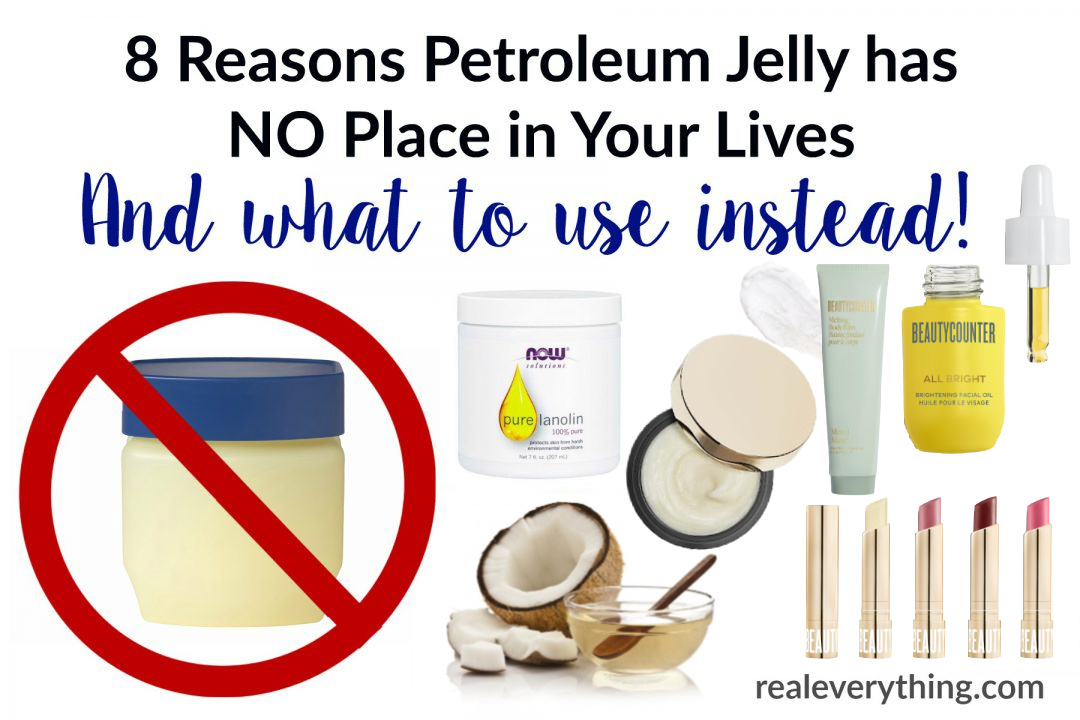
What to use instead
First off, make sure that if you’re trying to avoid petroleum (or other crude-oil b-products). Look for it by it’s many names… avoid:
- Petroleum
- Mineral oil
- Petrolatum
- Liquid paraffin
- Paraffin oil
The good news is, in this modern day and age there are SO many awesome other ways to get and stay hydrated safely. Here are some of our favorite alternatives:
Lanolin
The oil from sheep’s wool, is known to be the safest way to protect mom’s chapped nipples during breastfeeding because it’s one of the few food-grade protective oils. That should tell you a lot about it’s safety, since infant gut health is a tricky, sensitive, important thing! Unlike Vaseline, it is semi-occlusive, which means it has a breathable barrier. Like Vaseline, it will “seal and protect” to lock-in moisture, but it actually holds 400 times its weight in water (source) while also allowing your skin to breathe and take in moisture. Overall, this is ideal to help the skin – especially when dried, cracked, or chafed. You can mix it with other natural oils and butters to create a “lotion” like texture. [available to purchase here]
Coconut Oil
The original natural skincare catch-all, coconut oil is a wonderful multi-purpose oil. Or really, a fat since it solidifies at room temperature. Our cells and skin need lipids to hydrate, which allows coconut oil to be used from hair, nails, and skin to health benefits in your food. A more “refined” (use a high quality not-heat-processed oil to avoid oxidation) oil will have less of a scent. The complication with coconut oil is that it can be irritating to some skin types, causing anywhere from rash and bumps to acne from clogged pores. Make sure to test use before going hog wild putting that stuff on everything!
Beautycounter’s Lotus Glow Cleansing Balm
Most similar in texture to Vaseline, the Cleansing Balm is designed to be gentle enough for sensitive skin but includes antioxidant-rich Vitamin C and a blend of lotus extract, jojoba seed oil, and avocado seed oil. Lotus Glow Cleansing Balm soothes and destresses skin. After just one week of use:
- 100% said skin felt nourished and more hydrated while
- 97% reported no greasy residue left on skin. [available to purchase here]
The balm is used by customers to heal cracked skin on hands, elbows and heels as well as a hydrating mask for the face. The barrier balm is the ultimate hydrating powerhouse because of the mix of jojoba, Vitamin E, Vitamin C, and botanicals. Read more about the magic of this and other Vitamin E-rich products here.
Beautycounter’s All Bright Brightening Facial Oil
This is the product I have seen the most drastic improvement in my skin. I replaced straight coconut oil. Specifically, even organic coconut oil caused inflammation and irritation in the form of acne for me. I believe it’s just too saturated and heavy, causing clogged pores. The mix of oils specifically created for your skin’s needs, these “dry” oils soothe and soften skin for a nutrient-rich skin superfood nourishing experience. The formula work for all skin types and quickly absorb without ever feeling greasy. Learn the science of why our skin needs lipids here.
- 91% said skin looked brighter
- 94% said skin looked more glowing and radiant
- 97% said skin felt immediately hydrated
- 91% said skin looked revitalized and renewed
Beautycounter’s Clean Swipe Hyaluronic Lip Balm
I have yet to meet a single person who doesn’t love the Beautycounter Lip Balm. With responsibly sourced palm with both EWG Verification and Vegan formula that’s tested for safety. Gluten and peanut-free, with no hormone disrupting chemicals, heavy metals or mineral oils, this buttery soft balm is nourishing and conditioning. Infused with hyaluronic acid plus Vitamin-E rich fatty acids from mango and murumuru seed butter as well as jojoba seed and avocado oils, 100% of users said:
- lips felt moisturized after use
- felt conditioned and nourished
- agreed formula didn’t dry out lips (like petroleum and other waxes can)
- said formula applies effortlessly and glides on easily
The ingredients, unlike petroleum, are food grade. Infused with lip-loving ingredients for advanced nourishment that leaves lips soft and supple, without a greasy residue. Creamy, buttery texture that melts into lips for lightweight and comfortable wear. Can be applied to cheeks in a pinch for a dewy glow. Choose from color options or “nada” for transparent.
Beautycounter’s Melting Body Balm
More than a moisturizer— the tag line is “a vacation for your senses”. Infused with an intoxicating monoi scent (no petrochemical fragrances), this luxurious balm transforms into an oil as it melts into the skin. Its nourishing formula—which features argan and avocado oils—helps hydrate and soften, giving skin a healthy-looking glow. Massage into damp skin after bathing to lock in moisture. Can be used as a conditioning treatment for cuticles, elbows, and dry spots. [available to purchase here]
- 100% said skin felt hydrated, soft, and silky
- 100% said appearance of dryness/ashiness was reduced
- 94% said the product absorbed quickly into skin
- 88% said skin looked radiant, luminous, and glowing
Beautycounter’s Superquench Body Butter
You won’t find any mineral oils in this luxurious rich and thick body butter (like a thick lotion). Get quenched. Made with a hydrating blend of hyaluronic acid, peptide-rich acacia seed extract, shea butter, and mango butter, this ultra-rich body butter is formulated to leave skin softer, smoother, and healthy-looking. Decadent and effective, it glides on smoothly and absorbs quickly—without feeling greasy. Plus, it’s infused with a spa-worthy monoi scent to make your body-care routine feel more like me-time. [available to purchase here]
Benefits:
- Deeply hydrating, leaving skin feeling soft, smooth, and healthy-looking.
- Rich, non-greasy formula glides on easily.
- Formulated with an intoxicating monoi scent without any “fragrance” but only real, transparent ingredients.
Featured Ingredients:
- Acacia Seed Extract: Rich in peptides, this ingredient helps to reduce moisture loss and reinforce the skin barrier.
- Shea Butter: Moisturizes and conditions for softer, smoother-looking skin.
- Mango Butter: Helps to moisturize and provide a texture that glides easily onto skin.
- Sodium Hyaluronate: A form of hyaluronic acid that contributes excellent moisturization benefits to help enhance skin smoothness for more hydrated, supple-looking skin.
Results:
- Clinically demonstrated to provide 24-hour hydration.*
- 100% said the appearance of ashiness was reduced.**
- 100% said skin looks supple, hydrated, and toned.
- 97% said skin feels deeply hydrated and conditioned.
- 97% said skin looks youthful.
References: (1) So Long Psoriasis, (2) Healthline, (3) Livestrong, (4) Beauty Editor
Learn more about the Science of Skin and Supporting the Skin Barrier for Dry Winter Skin and my other Dry Skin Hero post here.
Never want to miss a post, sale, or deal? Join my Healthy Inside & Out e-mail list for more info on non-toxic living and safer skincare!Want more info on our Real Life?
Healthy recipes, parenting tips, and general lifestyle stuff goes out in our Real Everything newsletter, join here.

